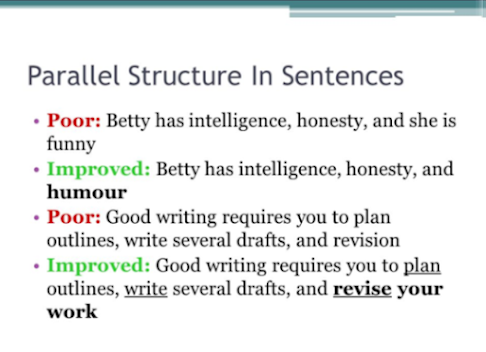The great importance of parallel
construction in presenting ideas
By Jose A. Carillo
Part III – Presenting ideas in parallel
We have already taken up the two basic rules for parallel construction, namely that a sentence that presents two or more serial elements should stick to the same pattern all throughout, and that a parallel structure that begins with a clause should sustain that pattern all the way. We saw that we can build much clearer and more forceful sentences by consistently observing these rules.
Now we need to refamiliarize ourselves with four specific applications of these two parallelism rules: (1) that all of the elements being enumerated in a list should take the same grammatical form, (2) that elements being compared should take the same grammatical form, (3) that elements joined by a linking verb or a verb of being should take the same grammatical form, and (4) that elements joined by a correlative conjunction should take the same grammatical form.
IMAGE CREDIT: SLIDEPLAYER.COM
All elements in a list should have a parallel structure. We can make our written compositions better organized and more readable by using the same grammatical form for all the elements we are enumerating in a list. The elements should all be noun forms, verb forms, infinitive phrases, gerund phrases, or participial phrases, whichever is most appropriate. When we allow any of the elements to take a different form, the rhythm of the enumeration is broken and the reader’s train of thought is needlessly disrupted.
Consider the following not-so-well-thought-out list:
“At present, our club has: (1) no formal charter, (2) subsisting without a long-term organizational goal, (3) a seriously declining membership, (4) a large budgetary deficit, and (5) to collect a large amount of past-due membership fees.”
The list looks awfully craggy and reads very badly for an obvious reason: its elements don’t follow a consistent grammatical form. Items 1, 3, and 4 are noun phrases, but Item 2 is a verb phrase in the progressive form and Item 5 is an infinitive phrase.
Now see how smoothly and cohesively the list reads when its elements all take the same grammatical form, in this case as verb phrases:
“At present, our club: (1) lacks a formal charter, (2) subsists without a long-term organizational goal, (3) suffers from a seriously declining membership, (4) carries a large budgetary deficit, and (5) needs to collect a large amount of past-due membership fees”.
Elements being compared should use a parallel structure. In constructions that use the form “X is better than/more than Y,” we have to make sure that the elements being compared have the same grammatical structure. Unparallel (gerund/infinitive): “She enjoys jogging better than to run.” Parallel (gerund/gerund): “She enjoys jogging better than running.”
Elements joined by a linking verb or a verb of being should use a parallel structure. When we use “is” as a verb of being that links two elements, we have to make sure that the elements have the same grammatical structure. Unparallel (infinitive/gerund): “To make that impossible demand is declaring open hostilities.” Parallel (infinitive/infinitive): “To make that impossible demand is to declare open hostilities.”
Elements joined by a correlative conjunction should use a parallel structure. When we use the correlative conjunctions “either . . . or,” “neither . . . nor,” “not only . . . but also,” “both . . . and . . .”, and “whether . . . or,” we have to make sure that the elements being correlated have the same grammatical structure.
Unparallel (gerund/infinitive): “For you to get to Manila on time, we suggest either taking the morning flight tomorrow or to drive overnight right now.” Parallel (gerund/gerund): “For you to get to Manila on time, we suggest either taking the morning flight tomorrow or driving overnight right now.”
Unparallel: “They not only demand very short installment periods but also huge down payments.” Parallel: “They demand not only very short installment periods but also huge down payments.” Also parallel: “They not only demand very short installment periods but also demand huge down payments.”
We will take up some more fine points about parallelism in Part IV of this essay.
Next:
Part IV – Presenting ideas in parallel
June 29, 2023 (Thursday)


No comments:
Post a Comment